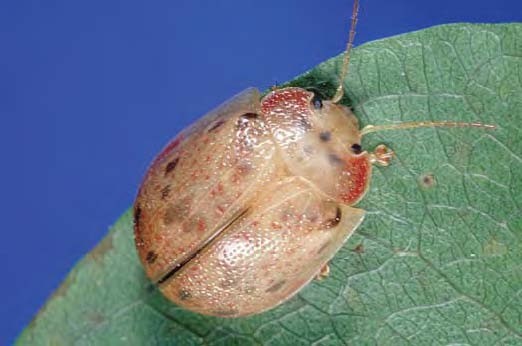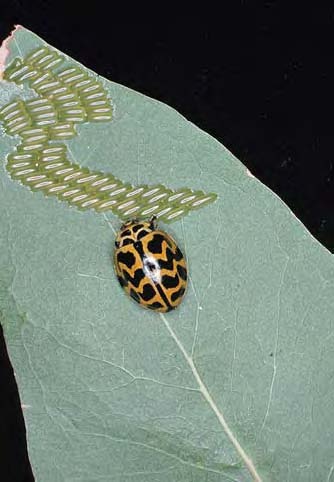PESTS AND DISEASES OF FORESTRY IN NEW ZEALAND
Best laid (biocontrol) plans…
From Biosecurity 59, May 2005.
By Margaret Richardson
When eucalyptus trees were established in New Zealand many years ago, they were a forest-grower’s dream. Certain species grew fast, produced attractive hardwood and were excellent for pulp. But the fairy-tale plantation crop was destined for trouble when the eucalyptus tortoise beetle, Paropsis charybdis, entered the scene. The arrival of this pest triggered an ecological mini•drama that perfectly illustrates the complexity of biological-control systems.

Paropsis found its way across the Tasman early last century, bringing with it a voracious appetite for eucalyptus foliage. Eucalypt growers watched in despair as stands of favoured species were repeatedly stripped of their leaves. When chemical sprays proved impractical, the search was on for a biological “good-guy” who could stop the villain in its tracks.
In the late 1970s, Forest Research scientists introduced Cleobora mellyi, a biological control agent that it was hoped could run the pest out of town. Although the tiger-striped Australian ladybird enjoys Paropsis eggs and larvae as part of its diet, it failed to thrive in New Zealand eucalypt plantations. Cleobora was liberated at two sites, one in the central North Island and one in the Marlborough Sounds, but became established only at the latter. With prospects for the ladybird not looking good, Forest Research scientists lined up another potential champion.
Enter Enoggera nassaui, a parasitic wasp deliberately introduced from Australia in 1987. Dr Sarah Mansfield, a Forest Research entomologist, says that Enoggera proved to be a very effective control agent, storming clusters of Paropsis eggs and laying its own eggs inside them. By eating the enemy’s eggs inside-out, the heroic Enoggera looked set for victory. But the unexpected arrival of a new bad-guy foiled the best-laid plan.

Baeoanusia albifunicle is an Australian wasp that crept into New Zealand undetected in 2001 and began to prey on Enogerra. Sarah explains that while Enoggera was laying its eggs in Paropsis, Baeoanusia was, in turn, busy laying its eggs in Enoggera, thereby undoing all the good that the biological control programme had achieved. With its predator itself under attack, Paropsis bounced back and continued its relentless attack on the defenceless eucalypt trees.
As the struggle between parasitoid and hyperparasitoid played out in the chewed plantations, forest managers and scientists saw a fresh role for Cleobora, the ?rst of the biocontrol agents that had failed to thrive after it was introduced in the 1970s. In a new bid to cut Paropsis off at the pass, they collected Cleobora from the Marlborough Sounds and are now mass-rearing them for another go at releasing them into North Island plantations.
Sarah says that while Cleobora did not establish well when it was first introduced, the predatory insect will now stand a better chance of survival due to changes in the forest ecosystem. “Cleobora seems to like a mixed diet of Paropsis eggs and psyllids. With all the new species of Australian insects that have found their way into the country, there is a much bigger range of psyllids in the North Island forests than there was twenty years ago.”
As highlighted in other articles in this issue of Biosecurity, importing new organisms as biological control agents into New Zealand involves significant work to establish that they will not pose an environmental hazard – so Sarah believes it is worth giving Cleobora another chance. Given that New Zealand produces up to $100 million worth of plantation hardwoods a year, forest owners agree. The redeployment of Cleobora was initiated by farm forester, Dean Satchell, with support from the MAF Sustainable Farming Fund. Further funding is provided by the Forest Biosecurity Research Council (FBRC), a collaborative venture between MAF, Forest Research, the New Zealand Forest Owners’ Association and Lincoln Centre of Research Excellence (CoRE).



